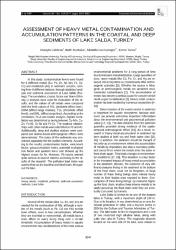| dc.contributor.author | Çaldırak, Hüseyin | |
| dc.contributor.author | Kurtuluş, Bedri | |
| dc.contributor.author | Canoğlu, Mustafa Can | |
| dc.contributor.author | Tunca, Evren | |
| dc.date.accessioned | 2020-11-20T14:54:09Z | |
| dc.date.available | 2020-11-20T14:54:09Z | |
| dc.date.issued | 2017 | |
| dc.identifier.issn | 1018-4619 | |
| dc.identifier.issn | 1610-2304 | |
| dc.identifier.uri | https://hdl.handle.net/20.500.12809/2106 | |
| dc.description | WOS: 000419539900051 | en_US |
| dc.description.abstract | In this study, contamination levels were found for 8 different metals (Cu, Pb, Zn, Ni, Mn, Fe, Cd, Cr) and metalloids (As) in sediment samples, coming from 9 different stations, through statistical analysis and sediment assessment at Lake Salda (Turkey). The correlation, cluster, factor and Mann Whitney-U analysis were used for evaluation of the results, and the values of all metals were compared with the limit values of PEL (probable effect level), ERM (effect range median), TEL (threshold effect level), and ERL (effect range low). According to the correlation, PCA and cluster analysis, highest correlation was determined as being between Cu-Mn, Cu-Zn, Fe-Ni, Cr-Ni and Fe-Cr. The weakest relationships with other metals were identified as Pb and As. Additionally, deep and shallow stations were compared and station-based anthropogenic effects were demonstrated. The status of the sediments was considered separately for the studied elements. According to the results, contamination factor, enrichment factor, geoaccumulation index, potential ecological risk factor and quotient toxic unit showed up the highest values for Ni. However, Pb results seemed quite serious at several stations according to the results of the research. The pollution load index was used to find out the baseline and ideal levels throughout the lake. | en_US |
| dc.description.sponsorship | The Scientific and Technological Research Council of Turkey (TUBITAK)Turkiye Bilimsel ve Teknolojik Arastirma Kurumu (TUBITAK) [113Y408, 2210/C-2015]; Mugla Saki Korman University [BAP 15/048] | en_US |
| dc.description.sponsorship | The authors give thanks to The Scientific and Technological Research Council of Turkey (TUBITAK) "113Y408", "2210/C-2015", and Mugla Saki Korman University "BAP 15/048" projects for their financial support. | en_US |
| dc.item-language.iso | eng | en_US |
| dc.publisher | Parlar Scientific Publications (P S P) | en_US |
| dc.item-rights | info:eu-repo/semantics/openAccess | en_US |
| dc.subject | Heavy Metals | en_US |
| dc.subject | Metalloid | en_US |
| dc.subject | Pollution | en_US |
| dc.subject | Sediment Assessment Methods | en_US |
| dc.subject | Lake Salda | en_US |
| dc.title | ASSESSMENT OF HEAVY METAL CONTAMINATION AND ACCUMULATION PATTERNS IN THE COASTAL AND DEEP SEDIMENTS OF LAKE SALDA, TURKEY | en_US |
| dc.item-type | article | en_US |
| dc.contributor.department | MÜ, Mühendislik Fakültesi, Jeoloji Mühendisliği Bölümü | en_US |
| dc.contributor.institutionauthor | Kurtuluş, Bedri | |
| dc.identifier.volume | 26 | en_US |
| dc.identifier.issue | 12A | en_US |
| dc.identifier.startpage | 432 | en_US |
| dc.identifier.endpage | 446 | en_US |
| dc.relation.journal | Fresenius Environmental Bulletin | en_US |
| dc.relation.publicationcategory | Makale - Uluslararası Hakemli Dergi - Kurum Öğretim Elemanı | en_US |


















